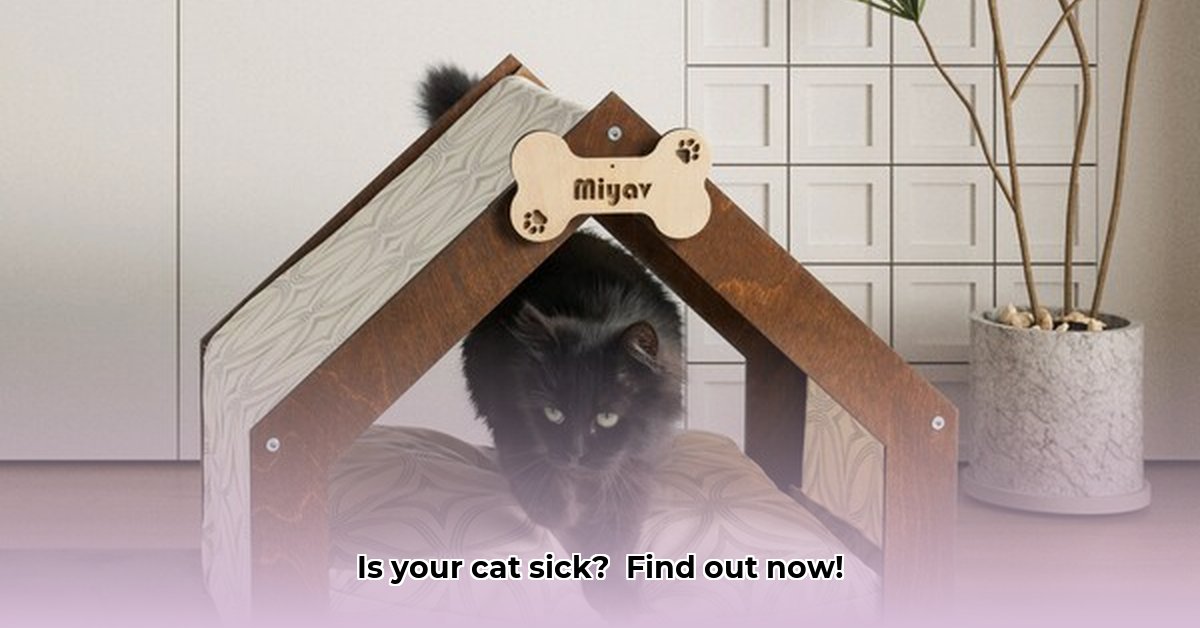Worried your cat might be sick? Lethargy, vomiting, and diarrhea aren’t just tummy troubles; they could be signs of feline parvovirus, a serious and highly contagious disease also known as feline panleukopenia. This guide will help you spot the early symptoms, understand how the illness progresses, and know what to do if your cat gets sick. We’ll cover everything from recognizing the first signs in kittens to preventing this nasty virus altogether, including why vaccinations are essential.. We’ll explain what to expect during treatment and give you a clear plan to keep your furry friend safe and healthy. Let’s learn how to protect your cat from feline parvo. For more information on feline parvo, check out this helpful resource: Learn more.
Feline Parvo Symptoms: A Fast Diagnosis Guide
Is your furry friend acting a little off? Understanding feline panleukopenia (FPV), often called feline parvovirus, is crucial for any cat owner. This virus attacks rapidly dividing cells in a cat’s body, particularly in the bone marrow, intestines, and immune system. While it sounds scary, early detection and swift action significantly improve your cat’s chances. Let’s break down the signs to watch for and what to do if you suspect something’s wrong. What proactive steps can you take to ensure your cat’s safety, especially if you have a kitten or an unvaccinated cat?
Early Warning Signs: Subtle Clues You Shouldn’t Ignore
Sometimes, the first signs of FPV are subtle behavioral changes. Your usually playful kitty might suddenly become unusually tired and sluggish — a common early symptom. They might lose interest in their favorite toy or even their favorite treats, indicating a loss of appetite. A normally cuddly cat might withdraw, preferring solitude and showing signs of depression. These seemingly small shifts can be big red flags. Don’t dismiss them; pay attention!
These early symptoms can easily be mistaken for other minor illnesses, making quick diagnosis tricky. Think back: has your cat’s personality changed? Did they once greet you at the door with enthusiasm, but now seem aloof? These behavioral changes, combined with other symptoms, are strong indicators. Also, be mindful if your cat is spending more time near their water or food bowl but is unable to consume much. The sooner you notice something’s amiss, the better. How can tracking your cat’s daily habits help in early detection and help you describe these changes to your vet?
Stomach Troubles: A Major Red Flag
Next, keep a close eye on your cat’s digestive system. FPV frequently shows up as significant gastrointestinal upset. Forceful vomiting, sometimes more than once and potentially containing bile, is a typical sign. Diarrhea is another key symptom; it could be watery or contain blood, suggesting serious intestinal inflammation. Abdominal pain may also be present, with your cat showing signs of discomfort like tucked bellies or arched backs. This combination often leads to rapid dehydration.
Imagine your cat’s body as a delicate balance. Persistent vomiting and diarrhea quickly deplete its fluids, leading to dehydration. You might notice sunken eyes, dry gums, and extreme lethargy. In severe cases, the intestines can become swollen, further complicating the condition. Dehydration is extremely dangerous and can quickly become life-threatening. Immediate veterinary care is essential when you see these signs. How quickly can dehydration become critical in cats, and what are the subtle signs one can look for when checking their gums?
Beyond the Gut: FPV’s Wider Impact
FPV isn’t just about an upset stomach; it’s a systemic disease. The virus attacks the bone marrow, which is where blood cells are made. This results in pancytopenia – a dangerous drop in all types of blood cells. (Pancytopenia is an acute deficiency of all blood cells). This weakens the immune system, leaving your cat vulnerable to other infections and hindering their ability to fight off the virus.
Think of your cat’s immune system as its army. FPV weakens these defenses, making it easier for other illnesses to take hold. This weakening isn’t always immediately apparent, but it significantly increases the severity of the disease and impacts its survival rate. What other infections can a weakened immune system allow to thrive, and how does pancytopenia specifically compromise the body’s defenses?
Less Common, but Still Important Symptoms
While less frequent, some cats also display neurological symptoms. These can include tremors, problems with coordination (ataxia), and in severe cases, seizures. These symptoms mean the virus has spread throughout the body, significantly worsening the prognosis. If you see these, seek immediate veterinary help. These symptoms arise because the virus can sometimes affect the brain, leading to impaired motor function and other neurological issues.
Another symptom, although not always present, is fever. A high temperature, especially in the early stages of the illness, might indicate your cat’s body is fighting the infection. However, in advanced stages, a cat’s body temperature may fall to lower-than-normal levels, which is a sign of impending death. If you have a rectal thermometer, you can check your cat’s temperature; however, always consult your vet for guidance on interpreting the results. What is a normal body temperature range for cats, and how can a fever or a drop in temperature indicate the progression of FPV?
When to Rush to the Vet: Don’t Delay!
Don’t wait for all the symptoms to appear before seeking help. If you notice any of the signs we’ve discussed, even if they seem minor, contact your veterinarian right away. Early treatment greatly improves the chances of a positive outcome. Your vet will perform stool and blood tests to confirm the diagnosis, looking for signs of the virus and pancytopenia, and create a treatment plan. Why is a proactive approach vital in managing FPV, and what specific diagnostic tests can a veterinarian use to confirm the infection?
Here’s a quick checklist to help you remember the key symptoms:
| Symptom | Description | Severity |
|---|---|---|
| Lethargy/Weakness | Unusual tiredness or weakness | High |
| Loss of Appetite | Stopped eating or drinking | High |
| Vomiting | Frequent, forceful vomiting, possibly with blood or bile | Very High |
| Diarrhea | Watery or bloody diarrhea | Very High |
| Dehydration | Dry gums, sunken eyes | Very High |
| Fever or Low Temp | Higher or lower than normal body temperature | Medium |
| Neurological Signs | Tremors, loss of coordination (ataxia), seizures | Very High |
| Abdominal Pain | Tucked belly, arched back, crying when touched | Medium |
Remember: Time is of the essence. Quick diagnosis and treatment are critical for your cat’s survival.
Prevention: The Best Medicine
The absolute best way to protect your cat from FPV is prevention! Vaccination is remarkably effective and readily available. Consult your veterinarian to create a vaccination schedule for your kitten, typically starting around 6-8 weeks of age, with booster shots as needed. Adult cats also need regular booster doses to maintain immunity. If one of your cats has a feline parvovirus infection, they must be isolated from other cats to prevent the spread of the disease. What is the typical success rate of FPV vaccinations in preventing the disease, and how do both live and killed vaccines work?
Think of vaccinations as providing a powerful shield against this dangerous disease. It’s a small price to pay for the peace of mind knowing your cat is protected. Don’t take chances; schedule those vaccinations today. How often should booster shots be administered to maintain effective FPV protection, and what factors might influence the frequency of these boosters?
How to Prevent Feline Panleukopenia in Kittens Under 12 Weeks
Key Takeaways:
- Feline panleukopenia (FP), or feline parvovirus, is a serious, highly contagious disease.
- Kittens under 12 weeks are especially vulnerable due to their developing immune systems and potential lack of maternal antibodies.
- Prevention is key; treatment focuses on supportive care to manage symptoms and prevent secondary infections.
Understanding Feline Panleukopenia
Feline panleukopenia is caused by a highly resilient virus. It’s incredibly contagious and can linger for months in the environment, contaminating cages, bedding, and other surfaces. Think of it like a tenacious weed – hard to eradicate. This means your kitten can get sick even without direct contact with another infected cat. The virus attacks rapidly dividing cells, making young kittens particularly susceptible. They’re essentially more vulnerable due to their immature immune systems. This leads to devastating symptoms. How long can the feline panleukopenia virus survive on surfaces, and what specific environmental conditions favor its survival?
Recognizing the Warning Signs
Early detection is crucial. The incubation period for feline parvo is typically between two to seven days after exposure. Are you seeing these symptoms in your kitten?
- Lethargy and weakness – a complete lack of energy.
- Loss of Appetite – refusing even favorite treats.
- Fever and dehydration – signs of illness.
- Vomiting and diarrhea – frequent and severe, potentially with blood.
- Abdominal pain – indicated by a hunched posture or sensitivity to touch.
If you notice any of these, get to your veterinarian immediately. Time is of the essence. Delaying treatment can be fatal. What specific visual cues indicate dehydration in kittens, and what is the immediate course of action a pet owner can take while en route to the vet?
The Importance of Vaccination
Vaccination is the
- Gluten Free Meal Prep Ideas for Delicious, Hassle-Free Eating - November 28, 2025
- Gluten Free Meal Prep for Stress-Free and Healthy Eating - November 27, 2025
- Quick And Easy Chicken Thigh Meal Prep For Weight Loss - November 26, 2025










